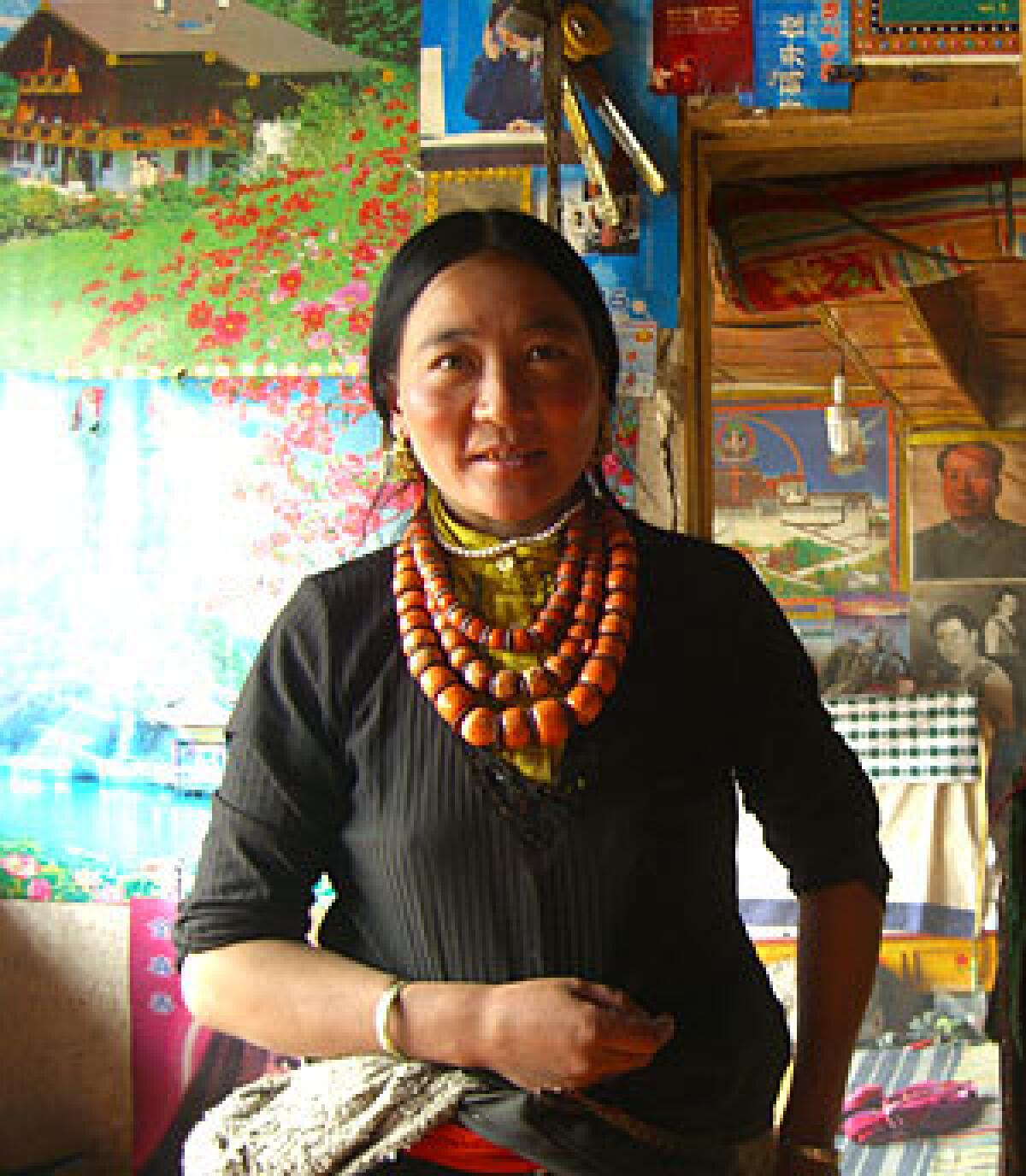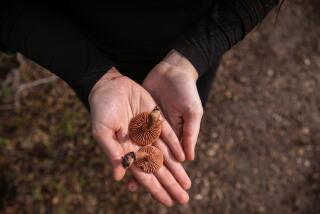In Tibet, a worm worth its weight in gold

HEITUSHAN, CHINA — Lhamotso never learned to read and write, and she has few marketable skills other than the ability to milk a yak.
Yet she can earn up to $1,000 a week these days, an unimaginable fortune for a Tibetan nomad. With the money, she has bought herself a shiny new Honda motorcycle. She and her husband gave up their tent for a house they built themselves with solar panels, a satellite dish and television.
The worm, Lhamotso explains, “has changed our lives.”
What Tibetans call the worm is actually not a worm but a fungus -- Cordyceps sinensis, to be precise -- that feeds on caterpillar larvae. Or, to give the fungus its more poetic name, “winter worm, summer grass,” because its appearance changes from one to the other with the seasons.
The worm is a prized ingredient in traditional medicines here, with prices in the last few years skyrocketing to the point where prime specimens are worth their weight in gold, literally, about $900 an ounce. Even the most ordinary pickings command prices rivaling that of French truffles, another famous fungus.
Because the caterpillar fungus is indigenous only to the 1,000-mile-long Tibetan plateau running from western China to Nepal, the money has hastened the nomads’ lurching transition into modernity.
“It is a bit like a gold rush in the Wild West. It’s brought enormous wealth to these communities,” says Andrew Fischer, an economist specializing in Tibet at the London School of Economics.
For centuries, Tibetan nomads added caterpillar fungus to their soups or tea, believing it boosted stamina, endurance, lung capacity, kidney function and, of course, sexual performance. Its use for medicinal purposes was documented as far back as the 14th century. But until recently, the fungus was cheap and abundant enough that Tibetans also would feed it to yaks and horses when their energy was flagging.
The fungus’ popularity took off after the 1993 World Championships in Athletics, when Chinese female athletes stunned the world by breaking records in nine track and field events and their coach gave partial credit to an elixir containing the fungus (along with turtle blood and deer penis).
More recently, Houston Rockets basketball phenomenon Yao Ming revealed that he too is a fan of the fungus. Then came the 2003 epidemic of SARS, sudden acute respiratory syndrome, which set Asian consumers off on a frenzy of buying anything that might boost immunity.
China last year exported $43 million worth of caterpillar fungus. In China and abroad, it is touted as a treatment for everything from impotence to aging.
“Yes! Grandma & Grandpa, you may not be a world-class athlete shattering world records, but wouldn’t it be great to feel like one?” claims one promoter out of Canada.
The center of the caterpillar fungus trade is in Qinghai province, particularly the Tibetan enclave of Golog. Here, the bu -- Tibetan for worm -- is by far the largest source of cash and dictates the pace of daily life. During the peak fungus hunting season, schools close down to allow children to help. People with jobs shirk work to prospect for riches.
The winding roads into the mountains are roped off with checkpoints run by police whose job is to keep out outsiders who might clash with locals. Every year, several people are killed in turf battles, often ethnically tinged, pitting Tibetans against Hui Muslims, another minority, or against Han Chinese.
The season runs for about 40 days, beginning in early spring when the snowmelt turns the mountains brown and spongy as though covered with a dirty shag carpet. Timing is crucial. If you dig too early, you get a live, wriggling caterpillar. It’s best to dig just after the fungus has killed the larvae.
For practitioners of traditional medicine, it is this strange interplay between the animal and the plant kingdoms -- the yin and the yang, as it were -- that makes the caterpillar fungus such a prize.
The best caterpillar fungus is found at higher elevations, places such as Heitushan, the 14,000-foot Black Earth Mountain in Golog, where Lhamotso lives.
The climb is steep, that even a nomad used to the elevation will be huffing and puffing, so Lhamotso counts herself lucky to have the motorcycle. She and her daughters, 10 and 16, pile on and zigzag uphill in a cloud of dust until the terrain gets too rough and they must walk.
Lhamotso, who like many Tibetans goes by one name, wears traditional clothes -- black wedge-heeled lace-up shoes and an ankle-length black dress, her head swathed in pink and turquoise scarves to keep out the sun and dust. Her daughters are more modern; the younger, Hiriti, in jeans and white sneakers, scrambles energetically up the mountain, helping her mother.
Children are useful on the hunt because their sharp eyes allow them to pick the fungus out of the clumps of grass and sodden earth -- a little like finding a needle in a haystack. Although the dead caterpillar is rather unprepossessing in appearance, it’s not nearly as disgusting as it sounds: sort of like a little yellow root with a stalk growing out of the top.
“It is very boring work,” complains Hiriti, who just this year began fungus-hunting at 10, the same age her mother started.
Reaching into the pocket of her faux leather jacket, the girl pulls out a tissue and unwraps what looks like a 3-inch-long twig, the only piece she found all day. She will sell it for about $3, but it could command a retail price of $10 in Singapore or Tokyo.
“I think people must be insane to pay so much,” Lhamotso says. “It’s only in the last two years it has gotten so expensive. It’s crazy, but it is good for us. How else would I make so much money? I can’t read or write.”
Lhamotso and the girls expect to make at least $6,000 this season -- about triple what most Chinese families earn in a year. Last year’s take was enough that Lhamotso and her husband built their house, the interior wallpapered with photographs from magazines of an assortment of celebrities, movie stars, Mao Tse-tung, the Dalai Lama.
Over a stove burning dung in the center of the main room, Lhamotso boils a kettle of water to make yak-butter tea, a salty brew popular here. The television is the only appliance.
The worm has helped pay for the house, but more important, it has provided the motivation and the money for Hiriti to get an education. The family pays $30 a month in tuition at a Buddhist monastery where Hiriti studies Tibetan, Chinese, a little English and math. (Lhamotso says they can afford tuition for only one child and that her older daughter is needed to help with traditional chores such as milking yaks.)
The caterpillar fungus has made it painfully apparent to Lhamotso and her husband how crippled they are by a lack of education. Neither can speak Chinese or do basic math. So they must rely on intermediaries, many of them Muslim traders, to do the counting, weighing, calculating and marketing of their pickings.
“We need to have one person in the family who is educated,” she says.
Lhamotso is well aware that fungus may not be a reliable source of income for much longer. The fungus is growing scarcer each year from over-harvesting and changes in the fragile ecosystem of the Tibetan plateau.
“When I was young, somebody could just walk out of the tent and dig 800 to 900 pieces in a day. Now we have to hike three hours up the mountain and the best we do is maybe 50 pieces,” says Tsering, 38, in a straw hat who was picking one afternoon with Lhamotso and her friends.
The bottom could drop out of the market if artificially cultivated caterpillar fungus catches on in Asia, as it has in the U.S., where much of the supply is cultivated. Many people believe that the prices for caterpillar fungus are ridiculously high and that the bubble will burst soon.
“It is expensive because it is rare and it is rare because it is over-exploited,” says Lin Zhibin, a pharmacology expert at Peking University Health Science Center.
Another concern is that the relentless digging on the mountains is contributing to soil erosion and desertification that keeps a perpetual cloud of dust swirling around Golog.
Although the caterpillar fungus has given the nomads a financial boost, Tibetan intellectuals remain ambivalent about its benefits to society as a whole.
“It is not good for the environment or for building harmonious society,” says Tseten Dargye, a Tibetan educator and a physician in Dawu, one of Golog’s main towns. “People have become territorial. There are a lot of fights between family and friends and the possibility of corruption.”
The real problem is that Tibetans themselves have become used to the easy money and the creature comforts it buys -- the motorized transit, the houses, the televisions.
“People can’t go backwards. For years, it’s been like digging up gold, but more valuable,” says Daodu, 31, a teacher. “People today can’t survive without it.”
More to Read
Sign up for Essential California
The most important California stories and recommendations in your inbox every morning.
You may occasionally receive promotional content from the Los Angeles Times.










